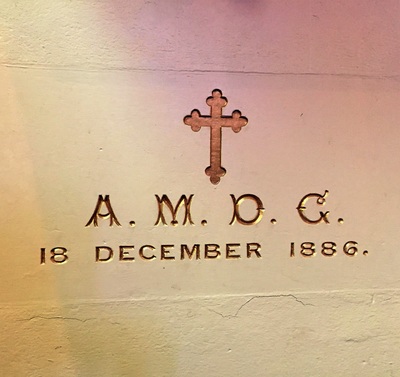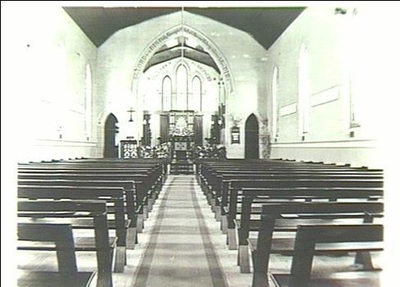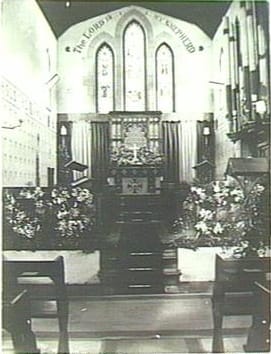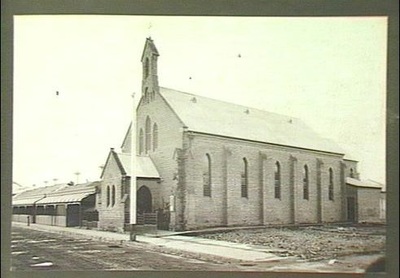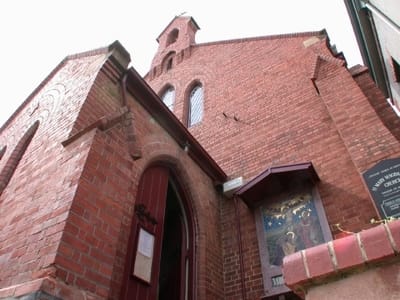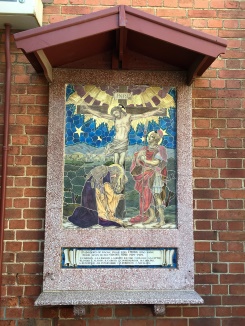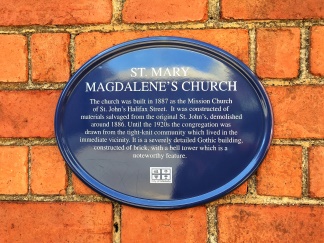Church history
|
St Mary Magdalene’s was founded in Moore Street in 1886. It was intended to be the centre of and for mission in the local community, and this has been the most important part of the church's ministry over the years. The founders sought to emulate the character of the Anglo-Catholic mission churches in the East End of London, and the catholic expression of Anglicanism has been the Parish’s driving force throughout its history.
The church in Moore Street, Adelaide, now known as St Mary Magdalene’s, grew out of the Parish of St John’s, Halifax Street, the second church in the Colony, founded in 1839. By 1883, the church at Halifax Street was too small for the congregation, but in any case the building was structurally unsound and was condemned. Following its demolition in 1885, a larger church was built, but the materials from the first building were conserved in anticipation of erecting another church as close as practicable to the centre of the city. The incumbent of St John’s, Fr Slaney Poole, purchased a block of land in Moore Street for £500 and a mission church, also named St John's, was built. It was built in much the same style, and using much of the material from the Halifax Street church, in an area deemed to be a spiritual ‘no man’s land’. South Australia at this time was caught in a depression period which continued almost to the end of the 19th century, and the immediate vicinity of the church was very much the poorest part of the city, dominated by many small, cheaply built worker’s cottages, and light industry. The foundation stone of the new “Mission Chapel of Ease” was laid by the Bishop of the Diocese on 18 December 1886, and the first service was held on 12 March 1887, in the presence of the Primate. A determined effort to ensure that the church was free of debt as soon as possible was achieved speedily, and the church was consecrated in the name of St Mary Magdalene on 4 May 1893. St Mary Magdalene’s was for a short time between 1906 and 1907 run in conjunction with the North Adelaide church of St Cyprian, prior to reverting to the charge of the parish of St John. It was then handed over to the bishop for a five-year period from January 1908. In the same year Fr Charles Hornabrook, a former Assistant Curate at St John's, was made “Missioner” of the church. (A much-loved and highly-respected priest, he was successively appointed Archdeacon of Mt Gambier, a Canon of the Diocese, and Archdeacon of Adelaide during his time at St Mary Magdalene's.) In 1919, St Mary Magdalene’s was given independent status. The church increasingly attracted worshippers from the suburbs, made possible by motorised transport. The congregation hitherto comprised working-class folk who lived in the immediate vicinity. In 1912, the Mission Hall was built by St Peter's College, which maintained a Mission at the church until 1957. Help was provided to families in need. Meals were provided to children, families received clothing, footwear and bedding at little or no cost, and a range of clubs and interest groups were set up. The Mission was a hive of activity, and effectively became the social centre of the district, and the community service dimension of the parish’s ministry. It also attracted significant support from the wider Adelaide community with regard to volunteers. By 1929 the Mission was completely integrated with the function of the parish, with a single budget managed by a joint committee. In 1935, the Mission provided more than 5,000 hot meals for children in the winter months, in addition to gifts of clothing, bedding and footwear, Christmas parcels, and much more. By 1946 there were eight people working in the Mission, including the headmistress of the Kindergarten, and a full-time Caretaker. In 1957, the St Peter’s College Mission resolved to move its operations to the then-new satellite city of Elizabeth, inaugurating a lengthy period of decline at Moore Street. The incumbent, Fr Howell Witt, one of the great ‘characters’ of the Anglican Church of Australia, resigned and moved to Elizabeth to support his former Assistant Curate from St Mary Magdalene’s, who had been charged with the establishment of the new Mission. The Parish elected to purchase the Mission Hall from St Peter’s College, necessitating the sale of property it owned nearby. Mission activities at Moore Street were maintained through the support of a small band of volunteers, but by 1966 the need for the Mission as it was then structured had ended. The Mission Hall was let to the Education Department, which operated a Special School from the building until 1979, when a theatre company signed a long term lease. In the 1970s, the population of the city of Adelaide reached its lowest ebb of just over 7,000 residents. (This was a drop from a peak in the 1920s of over 42,000.) Declining congregations brought financial pressure to bear, and by the late 1970s the parish had disposed of most of its property and the incumbent was, of necessity, taking on other appointments, to generate sufficient income to allow the maintenance of a full-time priest. The parish maintained a relatively untroubled, if financially precarious, status quo into the 1980s, but in 1987 the parish was dealt a grave blow when the incumbent resigned to found a local parish of one of the small breakaway Anglican groups which developed at about that time over issues of authority, particularly the ordination of women. This had the effect of dividing an already-small community, and within a short time, the parish declined to such an extent that the church was opened just once a week, for a single Sunday Mass offered by retired clergy. Since 1990, the parish has experienced sustained renewal in its life and ministry, beginning with the initiative of a group of young Anglicans and their friends who formed the Collective of St Catherine (later the Collective of St Mary Magdalene), and began a sandwich kitchen that distributed food in nearby Hurtle Square, and later the Saturday night Drop In Centre in the Mission Hall, for homeless and marginalised people. In 1993, the Magdalene Centre was founded in the parish as a joint venture between Anglicare SA and the city churches of St Mary Magdalene's, St John's Halifax Street and St Peter's Cathedral, for the provision of emergency assistance and community development programs to those in need. By the mid 1990s the Parish had returned to financial independence, and has since ventured actively into a range of ministries in the city centred on the church and Mission Hall, where a wide variety of experienced and talented volunteers and professionals are engaged in a range of community development activities, making for atypical variety in the life of the parish. Among the most important transformations in the ethos of the Parish over time has been its understanding of the ordained ministry of women, which has evolved, by God’s grace, to one of celebration and affirmation where once there was fear and doubt. We rejoice that women have ministered at our altars as deacon, priest and bishop, and at our leadership among Anglo-Catholic churches nation-wide in this sign of God’s redeeming love. Parish Priests 1886 The Revd Canon Frederic Slaney Pool (R. St John’s) 1895 The Revd Canon Walter Hopcraft (R. St John’s) 1906 The Revd Canon Ernest Herbert Bleby (R. St Cyprian's) 1908 The Ven Canon Charles Soward Hornabrook 1922 The Revd Canon Wilfrid Brougham Docker 1934 The Revd James Hardingham 1940 The Revd Percy Ferris 1948 The Revd Ernest Dilena 1954 The Revd Howell Witt (later Bishop) 1957 The Revd Malcolm Lindsay 1967 The Revd Ronald Herde 1975 The Revd Stephen Nicholls 1990 The Revd Graeme Kaines 1994 The Revd Grant Bullen 2003 The Revd Dr Ron Dowling 2011 The Revd Catherine Pennington SSM 2014 The Revd Stephen Clark 2022 The Revd Dr Steven Ogden Assistant Priests The Revd King William Pobjoy (A.C., St John's), 1894-1895 The Revd Robert William George Dempster (A.C., St John's), 1895-1901 The Revd Robert Monilaws Turnbull (A.C., St Johns), 1901-1904 The Revd Arthur George King (A.C., St John's), 1904-1905 The Revd Douglas Farnham Shield, 1955-1957 The Revd Brett Williams, 1991-1993 The Revd Bruce Stocks, 1998-1999 The Revd Neil Mathieson & the Revd Ruth Mathieson, 2000-2001 Deaconesses Deaconess Mildred Magarey, 1926-1928 Deaconess Winifred Mann, 1929-1934 Deaconess Mabel Walker, 1937-1954 |
